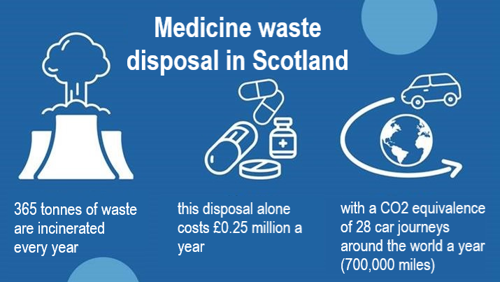The healthcare industry is increasingly asked to account for the negative environmental impact generated through providing medical care.
In Scotland, every 10 days a 10-tonne truck of medicines waste (from community and hospital pharmacies) is transported for incineration.
There are the associated costs for incineration; travel costs and the environment impact (see the image below showing the annual cost of managing medicines waste in Scotland) and in addition, direct costs of the unused medication.
There are many factors which contribute to medicines waste and a Department of Health and Social Care report in September 202113 showed that over prescribing is commonplace. Evidence is limited, but the review estimates that it is possible that at least 10% of the total number of prescription items in primary care need not have been issued.
This guidance supports reducing inappropriate prescribing through review of medication for those with long term health conditions. This includes promoting person-centred decision-making; providing guidance and support for clinicians and suggesting alternatives to medicines, where appropriate, such as physical, social activities and lifestyle change.

The Royal Pharmaceutical Society policy, ‘Pharmacy’s role in climate action and sustainable healthcare’14 , identifies medicines as contributing 25% of carbon emissions in the NHS. This can be reduced by:
- improving prescribing and medicines use
- tackling medicines waste
- preventing ill health; and
- improving infrastructure and ways of working.
With regular medication review to address inappropriate polypharmacy in T2DM (and other co-morbidities), the environmental impact can be reduced.
Small changes can have an impact, such as considering the use of re-useable insulin pens and cartridges rather than pre-filled pens, which have a lower CO2 footprint as well as reducing plastic waste. .
The RCGP15 has identified that prescribing accounts for over 60% of general practice’s carbon footprint.
Sustainable Markets Initiative (SMI)
The SMI established in 2020 identify seven levers to reduce carbon emissions in care pathways, many which relate to diabetes.16
- Decarbonising facilities and fleets
- Preventing disease onset – dietary and lifestyle management to prevent and manage T2DM
- Diagnosing early – to treat earlier and prevent long-term complications
- Optimising disease management – utilising newer therapies has positive long-term outcomes and reduces incidence of ASCVD, CKD and HF – see example below.
- Improving the efficiency of interventions – as above
- Delivering care remotely or closer to home when appropriate – digital innovations
- Using lower-emission treatments – re-usable insulin pens
It is estimated that an individual with T2DM and late-stage CKD requiring dialysis several times per week will have associated carbon emissions 70 times of someone managed with insulin, and 200 times those managed with oral hypoglycaemic therapies.
Of 100 individuals with pre-diabetes, 15% will develop cardiovascular or renal disease, accounting for 50% of the carbon emissions of this group.
Therefore prevention of and effective management of T2DM will have a positive environmental impact.
Pharmaceuticals in wastewater
The Royal Pharmaceutical Society's Sustainability Policies also point to the occurrence of pharmaceuticals in the environment. Every oral dose of a medicine taken is either excreted unchanged or converted to a metabolite with 30-100% entering our wastewater system which cannot currently remove all traces. The occurrence of pharmaceuticals in the environment is of global concern, and there is already evidence that they can affect aquatic wildlife, increase microbial resistance and enter the human food chain.
Evidence has already identified metformin and sitagliptin in waterways across the world, and further studies are needed identify the wider environmental impact of other anti-diabetic medication. These two examples highlight the importance of preventing diabetes and that all prescribing and review of medication should consider environmental impact and sustainability.17,18,19,20


